Beginning genetic material i.e., the template is different in all three types of PCR– regular, RT PCR and qPCR.
The basic PCR utilizes normal double-stranded DNA as a template. Whereas RT PCR permits only works with RNA as a template. qPCR is the most advanced version that is capable of working with both DNA and RNA as templates.
PCR and RT PCR only determine the presence or absence of a specific genetic fragment in a sample. However, qPCR has the competence to state the absence or presence of a gene in a given sample. As well as it can determine the amount of genetic material. For this reason, we classify PCR and RT PCR as qualitative techniques. Whereas qPCR is a quantitative technique.
Fundamental Principles behind PCR, RT PCR and qPCR
- PCR relies on the elemental idea of DNA amplification by altering the temperature zones.
- RT PCR depends upon the process of reverse transcription. Here, the template RNA is reversely transcribed to synthesise cDNA.
- qPCR depends on fluorescent dyes and probes that emit fluorescence as the reaction proceeds. This fluorescence keeps on increasing with the increase in the PCR product.
PCR, RT PCR and qPCR have become a normal part of human life after the covid pandemic outbreak. Thereby it becomes important to have a thorough understanding of these molecular biology techniques.
People certainly get confused between these terminologies and consider them synonymous. This content emphasises key differences between these three techniques.
Content: PCR, RT PCR Vs qPCR
Comparison Chart
| Basis for Comparison | PCR | RT PCR | qPCR |
|---|---|---|---|
| Meaning | Basic molecular biology technique to generate several copies of desired DNA fragment. | Complex but efficient PCR technique to amplify the RNA fragments by the process of reverse transcription. | A systematic and proficient type of PCR techniques mainly used for quantification of nucleic acids. |
| Principle | Primer amplification by the DNA polymerase enzyme | Complementary DNA (cDNA) is synthesised by the process of reverse transcription of RNA templates with enzyme reverse transcriptase. | Probe Hydrolysis or Fluorescence through intercalating dye |
| Type | Qualitative | Qualitative | Qualitative |
| Chemistry behind | Non- fluorescence | Non- fluorescence | Fluorescence |
| Template | Use double stranded DNA molecule. | Use RNA molecule as a template. | Both DNA and RNA can be used as template. |
| Primers | Simple and non-labelled forward and reverse primers are used. | Non - labelled reverse primers are used for reverse transcription. | Forward and reverse primers along with labelled probes are used. |
| Enzymes required | DNA Polymerase is used as an enzyme (mainly Taq polymerase) | Reverse transcriptase and DNA Polymerase. | Reverse transcriptase and DNA Polymerase. |
| Sensitivity | Less sensitive | More sensitive | Highly sensitive |
| Specificity | Low specificity | High specificity | High specificity |
| Complexity | Simple | Complex | Complex |
| Contamination chances | High as the reaction tubes are opened frequently for adding sample, reaction mixtures as well as for result detection through gel electrophoresis. | High as the reaction tubes are opened frequently for adding sample, reaction mixtures as well as for result detection through gel electrophoresis. | Very low chances of contamination as the reaction and result evaluation are done in unified closed qpcr system. |
| Workflow | Preparation of reaction mixture, amplification and agarose gel electrophoresis. | Preparation of reaction mixture, reverse transcription and formation of cDNA, amplification, agarose gel electrophoresis. | Preparation of reaction mixture, reverse transcription (if required), amplification, real time detection. |
| Steps | Denaturation, annealing and extension. | Reverse Transcription followed by normal PCR. | Reverse Transcription, PCR amplification followed by real time detection. |
| Result collection\ collection of data | At the end of the reaction. | At the end of the reaction. | During the reaction (exponential phase) |
| Result analysis | By running the PCR product in gel electrophoresis and visualising gel under U.V. Transilluminator. | By running the PCR product in gel electrophoresis and visualising gel under U.V. Transilluminator. | With the Peaks or Graphs of amplicons during the reaction. |
| Resolution | Low amplification resolution. | High amplification resolution. | Very high amplification resolution. |
| Applications | Nucleic acid amplification, Diagnosis etc. | Analyse gene Expression or detection of viral mRNA, viral disease diagnosis, construction cDNA library etc. | Research and development, Genome analysis, Cancer detection, Genetic engineering. |
Definition of Polymerase Chain Reaction (PCR)
In the 1980s, an American biochemist “Kary Banks Mullis”(1944 – 2019), invented Polymerase chain reaction (PCR). This technique entirely revolutionised the field of molecular biology. named
PCR facilitates the generation of several billion identical copies of DNA. Thus, it can be considered analogous to a “Photocopy machine”.
It enables the scientists to assess, amplify and analyse very short fragments of DNA even from trace amounts of sample. It plays a significant role in modern scientific domains like:
- Biotechnology
- Molecular biology
- Forensics
- Genetics
The PCR technique exploits the DNA polymerases enzyme to function. DNA polymerase bears the unique property by which it can synthesize the complementary strand using a template DNA.
The process of amplification occurs in a machine known as ‘Thermocycler’. The thermocycler provides the required range of temperature zones for the reaction.
Reaction mixture for PCR
A variety of ingredients are required for the PCR reaction, each having a specific and significant role. Some of the significant components are-
- Template: The desired DNA fragment which has to be amplified is used as a template for the reaction.
- PCR buffer: The PCR buffer generally is used to produce a suitable chemical environment for the reaction as well as prevents any change in the pH.
- MgCl2: The MgCl2 ions act as a cofactor for the activity of DNA polymerases, i.e. it enhances the work efficiency of Taq polymerase.
- Forward and Reverse Primer: The primers are short oligonucleotide sequences. These primers are peculiarly designed as per the gene of interest to be amplified.
- dNTPs: The DNA polymerase enzyme employs deoxyribonucleotide triphosphates at the end of the growing strand to continue the process of elongation.
- Taq Polymerase: Taq Polymerase is the DNA polymerase enzyme that serves as an engine for the PCR reaction. Its primary function is to incorporate the dNTPs into the growing complementary strand.
Note: The Taq polymerase is a heat-tolerant enzyme that is extracted from a bacterium named as Thermus aquaticus. This enzyme has the potential to bear extreme temperatures and thus doesn’t get denatured at the high temperature during the step of denaturation. - BSA: Bovine serum albumin plays the role of stabiliser in the PCR reaction as it stabilises the unwanted hindrance of some restriction enzymes at the time of DNA digestion. Thus, it ultimately helps in increasing the yield of PCR products.
- MiliQ water: It is a highly pure form of water as it contains no impurities in the form of ions, minerals, nucleases etc., thus providing a suitable medium for the dilution of PCR ingredients.
Steps in PCR
The PCR has an intricate procedure that is carried out in three essential steps at their distinct temperatures, respectively. These are-
- Denaturation: It is the initial step at which the two of the DNA strands are separated from each other under the effect of higher temperature. The temperature is raised upto 92- 95o C, due to which the hydrogen bonds between the two-strand break and the DNA is transformed into a single stranded form.
- Annealing: At this stage, the forward and reverse primers are attached to their respective complementary template strands. The annealing temperature is decided as per the melting temperature of the primer combination.
- Extension: This is the elongation time of the new strand. As the temperature reaches the optimal level, i.e. 72oC, the Taq polymerase is induced to incorporate the dNTPs into the growing strand. The time required for this step depends on the length of the template strand.
These three steps are repeated in the form of a decided cycle, which are prescheduled in the thermocycler machine. The cycle number of the reaction varies as per the sample used and required product yield.
Results analysis
As soon as the PCR reaction is completed, the results can be visualised with the help of agarose gel electrophoresis. The DNA will be obtained in the form of bands that can be seen under the U.V. transilluminator.
Definition of RT PCR
RT PCR or Reverse transcriptase PCR is a modified and modernised version of a basic PCR. The elementary PCR assisted the amplification of only those organisms having DNA as their genetic material. However, RT PCR eliminates this obligation. RNA is used as the beginning template in the case of RT PCR, allowing the amplification as well as detection of RNA also.
The RT PCR technique generally utilised the strength of the reverse transcriptase enzyme to revert RNA into complementary cDNA form. This probability proved to be an ultimate tool for RNA related researches and diagnostics.
The process of RT PCR necessitates two steps-
Step 1: The reverse transcription reaction
Step 2: PCR amplification
Being single stranded, RNA is highly unstable in nature and therefore is difficult to work with. The supplementary step of the RT reaction helps in subduing this problem.
In the first step, the RNA fragment is reversely transcribed into its complementary cDNA with the help of an enzyme reverse transcriptase. This cDNA now plays the role of template in the subsequent step of PCR amplification.
The major steps involved are:
- RNA Extraction: The desired RNA segment is isolated from the cells or tissues of the organism. This process can be done by the standard extraction protocol with TRIzole and can be tested with a spectrophotometer. RNA can also be extracted directly by using RNA extraction kits.
- Primer designing: Keeping the targeted gene in mind, the primers are designed. These primers are highly specific and are capable of developing and maintaining the duplex state with the template.
- cDNA Synthesis: Now, the RT reaction is used to clone the targeted genes by reverse transcribing the RNA. This leads to the formation of the complementary cDNA, which is further amplified using conventional PCR amplification.
- PCR Amplification: Here, the newly formed cDNA acts as the template for the basic PCR amplification.
Note: The quality, quantity and purity of the RNA template are the key benchmarks for performing the RT PCR as it is an exquisitely sensitive technique.
Definition of Real-time or qPCR
This variant of PCR is predominantly used for the quantification of nucleic acid and therefore is known as Quantitative PCR. This is the only PCR that can assert the exact amount of DNA or RNA present in the respective sample.
qPCR is a nuclear-derived method based on fluorescent dyes, radioactive probes and most frequently isotopic labelled markers. The underlying principle behind qPCR is the use of fluorescent dyes and labelled probes that aid the detection of a proportionally increasing amount of amplified product.
Major Approaches of qPCR
There are two major approaches for qPCR –
- The intercalator-based approach uses SYBR Green dye. This dye binds to the newly synthesised DNA fragments and emits fluorescence. The intensity of this fluorescence keeps on rising in an exponential manner with the increase in amplicons, which can be seen in the form of graphs and peaks.
- The Probe-based approach uses the TaqMan PCR probe. This needs a supplementary fluorogenic oligonucleotide probe along with a quencher dye and a reporter fluorescent dye attached to it.
Advantages of qPCR
There are two vital advantages of this technique –
- It allows the use of both the DNA and RNA to be used as templates. If the RNA is used as a template, in that case, the reverse transcriptase PCR becomes the first step of qPCR. This collaborated form of PCR is often termed as ‘RT- qPCR’.
- It determines the quantified results during the process itself, i.e. in the real-time of amplification, and thus, this type of PCR is also known as ‘Real-time PCR’.
A sole disadvantage of the qPCR is that only one specific kind of product in a sample can be amplified and detected at a time.
Key Differences Between PCR, RT PCR and qPCR
The above content can be summarised based on the following point–
- The PCR is a simple technique used for creating several copies of the desired DNA fragments. RT PCR, on the other hand, is used for the amplification of RNA. In contrast, qPCR is involved in the quantification of the nucleic acids in the respective sample.
- The PCR and RT PCR are qualitative techniques, but the qPCR is a quantitative technique.
- The initial template for PCR is double-stranded DNA, while RT PCR can only use RNA for a template. Apart from these, the qPCR has the ability to use both DNA and RNA.
- PCR is a technique with low sensitivity and specificity. On the contrary, RT PCR and qPCR are highly sensitive and specific.
- The resolution of the amplified product in the PCR is ultra-low. On the other side, the PCR products of RT PCR and qPCR have a higher level of resolution.
- Only DNA polymerase enzyme is required for the traditional PCR. But the RT PCR and qPCR requires both the reverse transcriptase and the DNA polymerase enzymes.
- PCR, as well as RT PCR, has no relevance with fluorescence, but the qPCR mainly is based on the fluorescence principle.
- The results of PCR and RT-PCR are obtained at the end of the reaction, but qPCR generates the results simultaneously in the form of peaks and graphs.
Conclusion
Either PCR, RT PCR or qPCR, these techniques serve as the backbone of the modern and revolutionised biological world. They literally have transformed the passage of conventional research and have made it simpler in many ways.
There are several advantages of RT PCR and qPCR over the traditional PCR method as they permit to work with RNA, helps in the quantification of nucleic material etc. yet the traditional PCR proves to be a reliable tool as it is easier to use, simpler, cheaper and requires less expertise to work on.

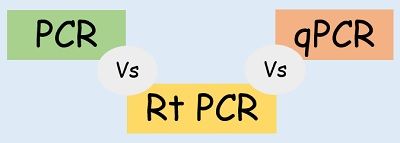
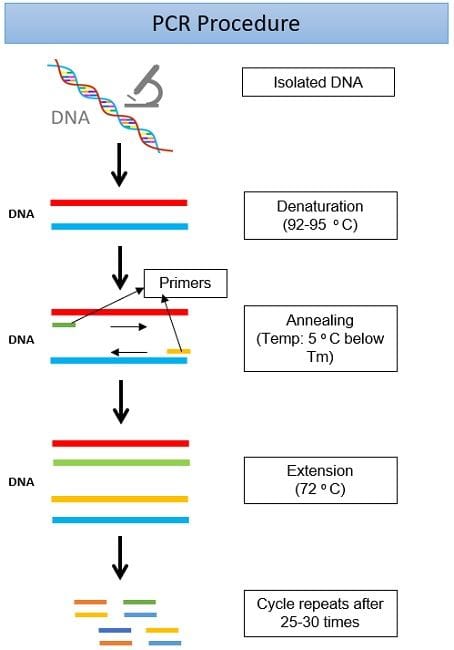
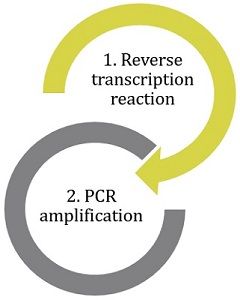
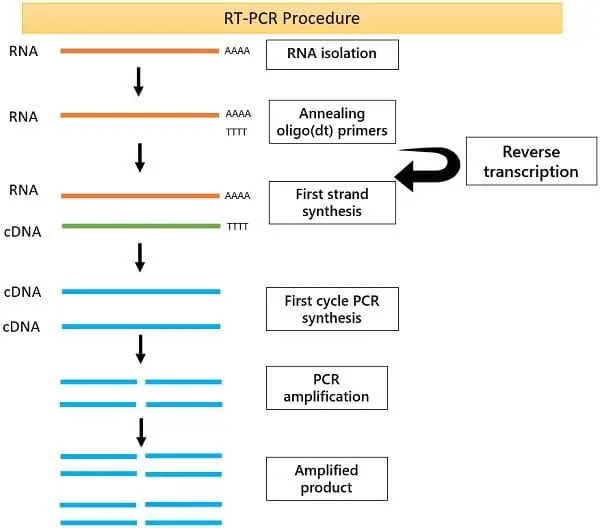
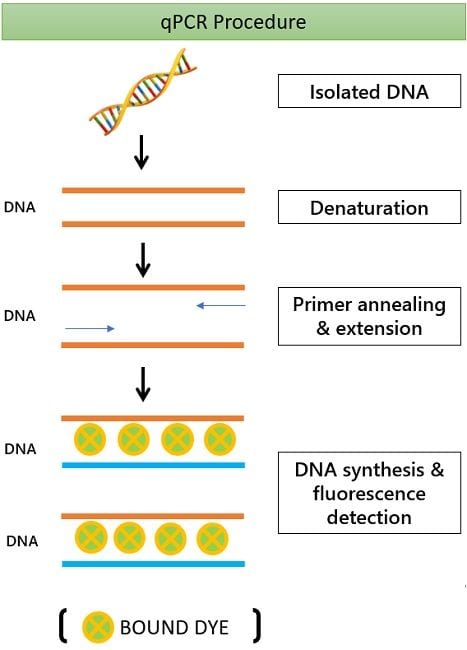
Leave a Reply